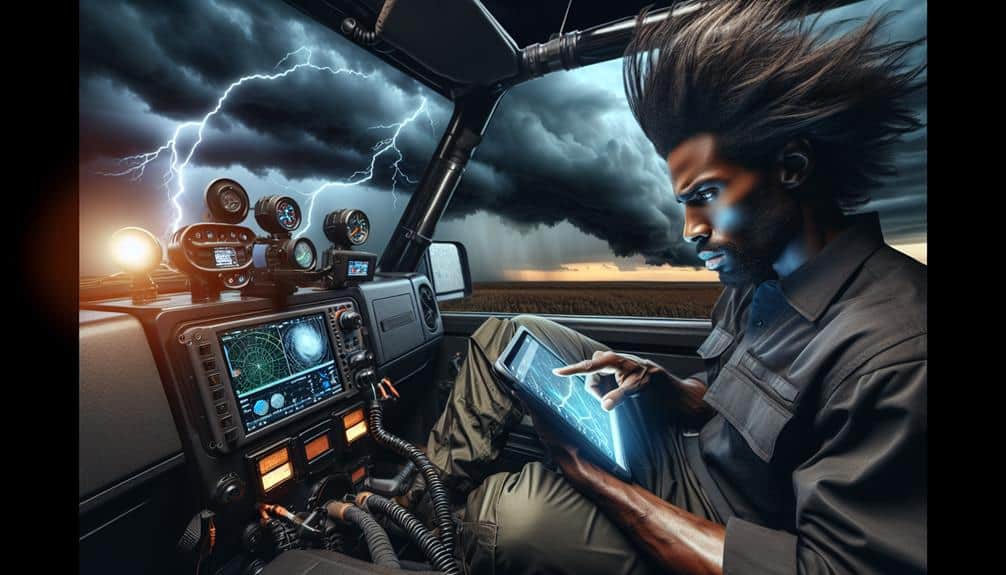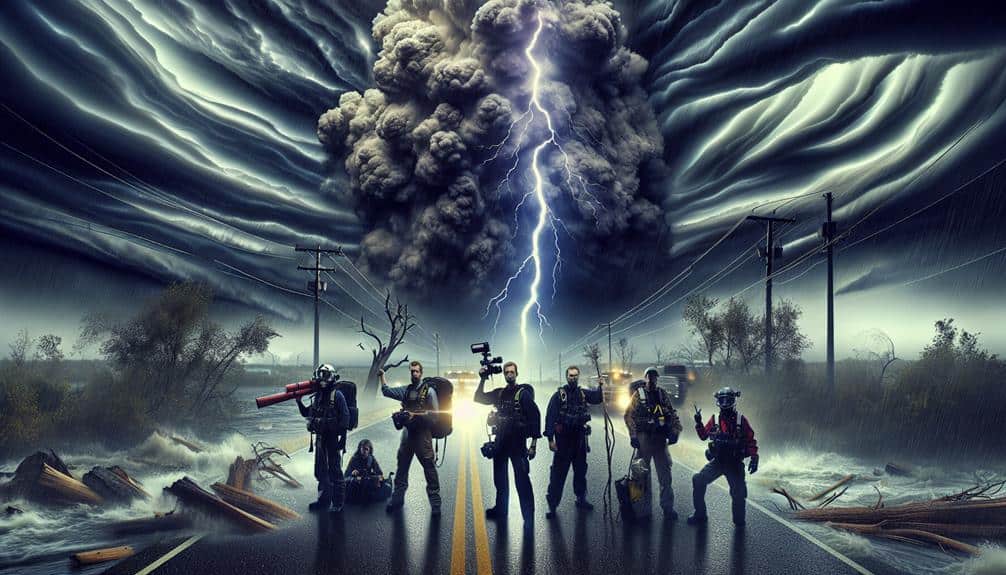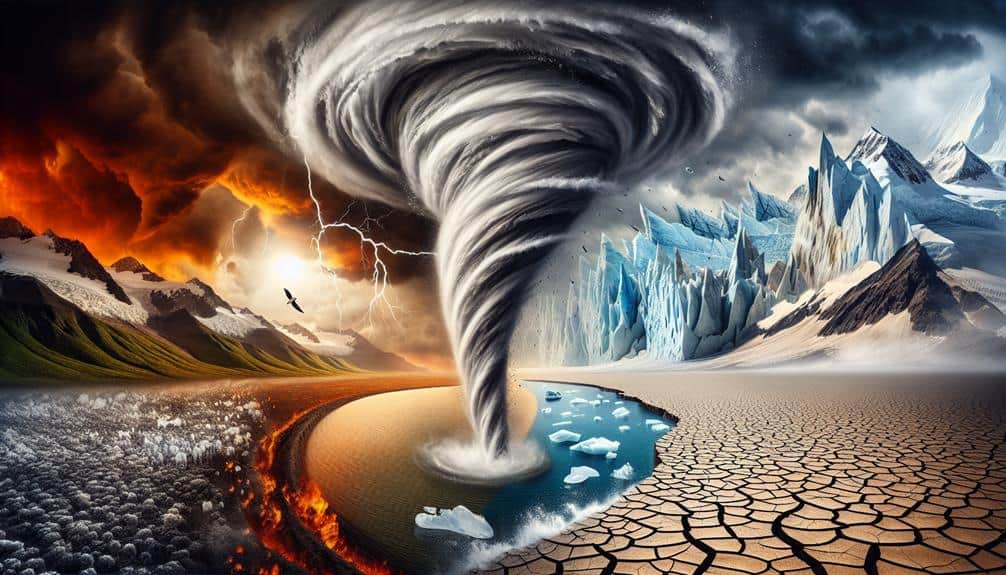To protect storm chasers from climate change, we utilize advanced weather monitoring tools like Doppler radar and satellite technology for up-to-date data on storm intensity and trajectory. Thorough training and certification guarantee we're proficient in risk assessment and emergency protocols. We also utilize specialized protective gear, such as waterproof clothing and dependable communication devices. Real-time data access from mobile weather stations enhances our decision-making, while mental health support helps us handle stress in high-stakes environments. These measures collectively improve our safety in the field. Explore more about how each component contributes to our safety and operational efficiency.
Key Points
- Advanced weather monitoring tools like satellites and Doppler radar provide real-time data on evolving storm conditions.
- Comprehensive training and certification ensure storm chasers are equipped to handle extreme weather scenarios caused by climate change.
- Protective gear and equipment include weather-resistant clothing, GPS devices, and reliable communication tools for safety in volatile conditions.
- Emergency communication systems utilize two-way radios and satellite phones for real-time coordination and rapid response.
Advanced Weather Monitoring
In storm chasing, we heavily rely on advanced weather monitoring tools to accurately predict severe weather events. Our primary technology includes satellite technology and radar systems. Satellites provide us with real-time data on cloud formations, storm systems, and atmospheric conditions. This data is essential for identifying potential storm developments and their trajectories.
Radar systems, on the other hand, offer precise, ground-level insights into storm activities. Doppler radar helps us measure wind speeds and precipitation rates, enabling us to assess storm intensity and make timely decisions. Combined, these tools enhance our situational awareness, allowing us to navigate safely and efficiently.
We also depend on climate modeling to understand broader weather patterns. These models simulate atmospheric conditions over time, giving us a clearer picture of potential weather scenarios. Improved forecasting accuracy from these models helps us anticipate severe weather events more reliably, minimizing risks during our chases.
Our dedication to these advanced technologies ensures we remain informed and prepared. By leveraging satellite technology, radar systems, and climate modeling, we can maximize our freedom to chase storms while prioritizing our safety. These tools form the backbone of our strategy, enabling us to operate with precision and confidence.
Protective Gear and Equipment
While advanced weather monitoring tools keep us informed, our safety on the field also hinges on the protective gear and equipment we use. When we're chasing storms, having the right protective clothing and gear can mean the difference between life and death.
Our first line of defense is usually protective clothing designed to withstand severe weather conditions. Waterproof and wind-resistant jackets and pants are essential, providing a barrier against torrential rain and high winds.
Moreover, safety equipment like helmets and goggles guarantees that we're shielded from flying debris, which is common in storm environments. We also rely on sturdy, waterproof boots with non-slip soles to maintain traction on slippery surfaces.
Advanced technology plays a vital role in our protective gear. For instance, GPS devices and mobile weather apps allow us to navigate and monitor real-time storm developments accurately.
In addition, having reliable communication tools is non-negotiable. Radios and satellite phones ensure we stay connected, even when cellular networks fail.
Training and Certification
Let's focus on the importance of training and certification for storm chasers. Thorough skill development guarantees we can handle the complexities and dangers of storm chasing, while certification programs set the standards for safety and professionalism.
Data shows that certified storm chasers are notably less likely to encounter life-threatening situations.
Comprehensive Skill Development
Proper training and certification are crucial for storm chasers to guarantee their safety and effectiveness in the field. Our approach to thorough skill development emphasizes hands-on experience and practical training. By engaging in field research, we enhance our observational skills, enabling us to predict and respond to volatile weather patterns accurately.
Practical training involves simulated storm scenarios where we practice real-time decision-making and risk assessment. This method not only builds our confidence but also hones our abilities to operate under pressure. Additionally, we utilize advanced meteorological tools and techniques to interpret data, allowing us to make informed decisions swiftly.
Field research is another vital component. By studying storms in their natural environments, we gather valuable data that contributes to our understanding of climate change's impacts on severe weather events. This observational approach ensures that we remain skilled at identifying key indicators that precede storm formation and escalation.
Through this rigorous skill development process, we prepare ourselves to face the unpredictability of storm chasing. Our commitment to ongoing training and research not only protects our lives but also equips us with the knowledge to contribute meaningfully to meteorological science. This in-depth approach ensures we're always ready to navigate the challenges posed by an evolving climate.
Certification Program Standards
To confirm the highest standards of safety and competence, our certification program mandates rigorous coursework and practical assessments. These measures make certain that storm chasers are well-prepared to face the unpredictable challenges posed by climate change. Our training modules are meticulously designed to cover every aspect of storm chasing, from understanding meteorological data to implementing effective safety protocols.
Our certification process includes:
- Field Experience: Trainees must complete a minimum of 100 hours of supervised field experience. This hands-on training ensures they can apply theoretical knowledge in real-world scenarios, enhancing their decision-making skills during storm events.
- Safety Protocols: We emphasize safety through detailed instruction in emergency response procedures and equipment handling. Trainees learn how to create and follow thorough safety plans, reducing risks associated with severe weather conditions.
- Technical Proficiency: Candidates must demonstrate proficiency in using advanced meteorological instruments and software. This technical expertise allows them to accurately predict storm patterns and make informed decisions in the field.
Emergency Communication Systems
Effective emergency communication systems are essential for storm chasers to guarantee real-time coordination and safety during severe weather events. We rely on robust communication protocols to guarantee that every team member receives timely updates and instructions. These protocols include the use of two-way radios, satellite phones, and mobile apps designed for emergency response.
Having multiple channels of communication allows us to adapt quickly to changing conditions and maintain contact even when traditional networks fail.
To enhance our emergency response capabilities, we integrate Geographic Information Systems (GIS) and meteorological data into our communication platforms. This integration provides us with precise location tracking and enables us to share critical information promptly. By employing automated alerts and real-time messaging systems, we minimize the risk of miscommunication and safeguard that everyone is aware of potential hazards.
Moreover, we conduct regular drills to test our emergency communication systems and refine our protocols. These exercises help us identify any weaknesses and implement improvements.
A reliable communication network is our lifeline in the field, providing us with the freedom to focus on capturing valuable data while safeguarding our safety. By prioritizing effective communication, we can better navigate the increasing challenges posed by climate change.
Real-Time Data Access

Real-time data access is essential for storm chasers to make informed decisions and respond swiftly to rapidly changing weather conditions. By leveraging advanced technology integration and data analysis, we can greatly enhance our safety and efficiency in the field.
Integrating real-time data sources enables us to monitor atmospheric conditions, track storm development, and anticipate potential hazards. Here are three key components:
- Satellite Imagery: High-resolution satellite images allow us to observe storm systems from space, providing important insights into their formation and movement.
- Radar Systems: Doppler radar helps us detect precipitation, wind speed, and storm rotation, giving us critical information about a storm's intensity and trajectory.
- Mobile Weather Stations: Equipped with sensors, these stations offer on-the-ground measurements of temperature, humidity, and pressure, delivering localized data that can pinpoint microclimates and storm anomalies.
Our ability to access and analyze this real-time data is crucial. It empowers us to make split-second decisions, whether it's changing our route to avoid danger or positioning ourselves for the best observation. Advanced technology integration guarantees that we stay ahead of the storm, maximizing both our safety and our freedom to chase.
Mental Health Support
Addressing mental health support is important for storm chasers to maintain resilience and operational effectiveness in high-stress environments. We recognize that the intense nature of storm chasing can lead to significant psychological strain. Implementing structured support groups and counseling services is necessary for our well-being. These platforms provide a space to share experiences, discuss challenges, and offer mutual support, helping us process traumatic events more effectively.
Stress management and coping strategies are key components of our mental health regimen. Incorporating techniques such as mindfulness, cognitive-behavioral strategies, and relaxation exercises can mitigate the psychological impact of storm chasing. Data supports that individuals who regularly engage in these practices experience reduced anxiety and improved emotional regulation.
We should also consider integrating mental health training into our standard operating procedures. By doing so, we can better identify early signs of stress and burnout among our team members. Evidence-based approaches, such as peer support programs, demonstrate a significant reduction in stress-related symptoms.
Frequently Asked Questions
How Do Storm Chasers Manage Long Durations Without Access to Basic Amenities?
In the eye of the storm, we rely on survival techniques and remote communication. We use portable power sources, stockpile supplies, and stay connected via satellite phones and radios to manage long durations without basic amenities.
What Are the Legal Implications of Storm Chasing During Extreme Weather Events?
When we storm chase, we must consider liability risks and legal consequences. It's important to adhere to ethical responsibilities and safety precautions to avoid potential legal issues and guarantee everyone's safety during extreme weather events.
How Do Storm Chasers Handle Encounters With Wildlife During Their Missions?
When we face wildlife encounters, we take several precautions. Our safety protocols for wildlife interactions include maintaining distance, using deterrents, and having contingency plans. These measures guarantee minimal disruption and maximum safety during our missions.
Are There Insurance Options Specifically Designed for Storm Chasers?
Yes, there are insurance options specifically designed for storm chasers. They focus on risk mitigation by offering coverage options for equipment, liability, and medical expenses, ensuring we can pursue our passion with financial protection and peace of mind.
How Do Storm Chasers Balance Their Professional and Personal Lives?
Balancing our work life and personal relationships as storm chasers is a breeze—just like managing mental health and stress. Data shows effective stress management improves our work life balance, allowing us to nurture personal relationships despite the chaos.


